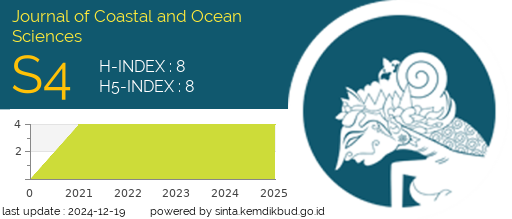Analysis of Indigenous Bacteria as Microplastic Degradation of Sediment in the Sea Waters of Dumai, Riau Province
DOI:
https://doi.org/10.31258/Keywords:
Microplastic sediment indigenous bacteria degradationAbstract
Nowdays Marine pollution resulted by microplastics is a global concern. Microplastic particles have the potential to cause damage to biota. One of solution to overcome the problem of marine pollution by microplastics by applying indigenous bacteria as microplastic degradation. This study was conducted to determine the type and ability of indigenous bacteria in sediments that are able to degrade microplastics. The research was conducted from October to December 2020. Sediment sampling was conducted in Dumai Sea Waters and sample analysis was conducted at the Marine Microbiology Laboratory, Faculty of Fisheries and Marine, Riau University. Indigenous bacteria from sediments were isolated in bacterial breeding media and then tested degradation capabilities on PET plastic samples. The result of the degradation test obtained ISL8 was able to degrade the mycoplastic with a percent degradation about 7%. Molecular test of ISL8 using PCR (Polymer chain reaction) 16S rRNA method and GenBank analysis is known that ISL8 is Bacillus sp.
Downloads
References
Afianti, N.F. (2018). Potensi bakteri laut untuk bioremediasi. Jurnal Kelautan. Oseana-XLIII (4) : 18–27.
Alex, S. (2011). New perspectives in plastic biodegradation. Journal of Current Opinion Biotechnology 22 (1) : 422 – 426.
Chubarenko, I., A. Bagaev, M. Zobkov, and E. Esiukova. (2016). On some physical and dynamical properties of microplastic particles in marine environment. Marine Pollutan Bulletin 108(1):1–2.
Hakiki, R.N. (2016). Identifikasi Bakteri pada Tempat-Tempat Penampungan Air Habitat Nyamuk Aedes aegypti. Skripsi. Universitas Islam Negeri Alauddin, Makassar.
Kurniati, T.H., R. Indrayanti, Muzajjanah, Y. Rustam, dan D. Sukmawati. (2018). Penuntun Praktikum Mikrobiologi. Fakultas Matematika dan Ilmu Pengetahuan Alam, Universitas Negeri Jakarta.
Lusher, A. L., H. Peter and M. Jeremy. (2017). Microplastics in Fisheries and Aquaculture. Roma: Food and Agriclture Organization of The United Nations.
Putri, M.H., Sukini dan Yodong. (2017). Mikrobiologi. Pusat Pendidikan Sumber Daya Manusia Kesehatan, Kementerian Kesehatan Republik Indonesia.
Sari, I.D., A.B. Aditya, dan I.R. Ramadhan. 2015. Distribusi mikroplastik pada sedimen di Muara Badak, Kabupaten Kutai Kartanegara. Journal Research Gate Indonesia, 4 (2) : 115 – 122.
Seprianto, Feliatra, dan T.T. Nugroho. (2017). Isolasi dan identifikasi bakteri probiotik dari usus udang windu (Penaeus monodon) berdasarkan sekuens gen 16S rDNA. Jurnal Ilmiah Biologi 5(2) : 83 – 92.
Sriningsih, A., dan M. Shovitri. (2015). Potensi isolat bakteri Pseudomonas sebagai Pendegradasi Plastik. Jurnal Sains dan Seni, 4(2) : 67–70.
Woodall, L.C., A. Sanchez-Vidal, M. Canals, G.L.J. Paterson, R. Coppock, V. Sleight, and R.C. Thompson. (2014). The deep sea is a major sink for microplastic debris. Royal Society Open Sience 1(4):1–8.
Wrigh, S.L., R.C. Thompson, and T.S. Galloway. (2013). The physical impacts of microplastic on marine organism: a review. Environmantal Pollutan, 178(1): 483–492






